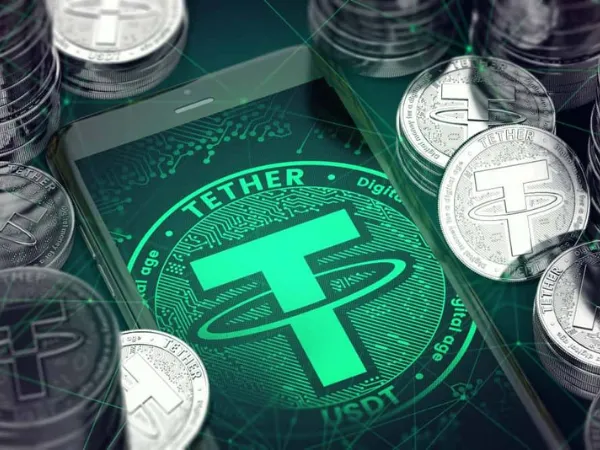Tether (USDT) is a Stablecoin often discussed for its continuous market presence in recent years within the Crypto market. So what exactly is Tether? What are its applications? In this detailed article, Vietnam-ustrade.org will provide specific and thorough information about this coin, so stay tuned!
What is Tether?
Stable coin
Before discussing Tether, it’s essential to define what a stable coin is. A stable coin is a type of cryptocurrency tied to fiat currencies such as USD, Euro, issued by a centralized company.
Stable coins enable the creation of currency pairs that correspond to fiat pairs on Crypto exchanges.
For example: The BTC/USDT pair is equivalent to the actual fiat pair BTC/USD.
Key factors a Stable coin must ensure:
- Decentralization
- Price stability
- High security
- Scalability
Tether (USDT)
Tether (USDT) is a type of Stable coin that is pegged to fiat currency, issued by Tether Limited (2014) with the goal of simplifying cryptocurrency and fiat currency exchanges.

Currently, USD is the fiat currency used by Tether, symbolized as USDT, where 1 USDT equals 1 USD. Besides USD, Tether also utilizes another currency, Euro, symbolized as EURT.
Note: Tether does not undergo price volatility typical of cryptocurrencies but is subject to fluctuations tied to the fiat currency it is linked to.
For example: If the USD or Euro halves in value due to political, economic, or other fluctuations, USDT will also decrease proportionally.
How Tether Works
Like digital assets pegged to Bitcoin, Tether operates on the Omni Platform and is maintained by collateral backing. This means 1 USDT is equivalent to 1 USD deposited in the system.
Specifically, when a buy transaction occurs, the created USDT matches the USD amount purchased (1 USDT = 1 USD). Similarly, in sell transactions, the corresponding USDT will be burned, matching the USD amount. This operational method helps ensure the total Tether in circulation correlates with the total USD deposits.
Pros and Cons of Tether
Advantages
Most investors in the cryptocurrency market focus on coins with significant price volatility as these offer opportunities for high profits. Tether, however, as a stable coin, maintains a steady price unaffected by pump-and-dump schemes, akin to depositing money into a bank account with zero interest. In reality, this is a highly useful digital currency with outstanding advantages that can replace fiat currencies, specifically:
Tether optimizes transaction time
Typically, using USD for transactions can take 1-4 days due to cumbersome procedures involving deposits/withdrawals, not counting delays caused by banks being closed or public holidays/weekends. With Tether, transactions are optimized to be completed within minutes, which is crucial for Traders, as the Crypto market tends to change rapidly and quick transactions are necessary to seize profit opportunities.
Tether saves transaction fees
Fees for fiat transactions are high, ranging from 20-30 USD per transaction, increasing with additional conversion costs and transfer percentages. Conversely, Tether transactions have zero fees when transferred between wallets.
Price stability of Tether (USDT)
When the Crypto market is volatile and unpredictable, and investors are uncertain about managing their digital assets, Tether acts as a “savior” due to its price stability.
If you convert all your coins to fiat cash and the market stabilizes, then want to buy/sell again, it takes a long time to re-enter the market. With USDT, you can easily trade at the right time without losing the value of your holdings.
Disadvantages
Besides its prominent advantages, Tether also has some limitations:
- To buy or sell USDT for Fiat money, you need to verify your identity by submitting ID documents, and it’s not possible to remain anonymous when sending or withdrawing USDT as usual.
- While being a stable coin, the USDT exchange rate can still fluctuate by 2-3% over time.
- Tether lacks publicly accessible mining terms; the issuing company holds exclusive rights, which may hinder maintaining a fixed value against USD.
Guide to creating a Tether (USDT) wallet for Beginners
You can create a Tether wallet to store USDT on personal electronic wallets if you only intend to accumulate Tether, or you can store Tether on exchanges if you frequently trade BTC or other Altcoins.
Which Tether wallet is best?
So, what are the best Tether wallets? Consider the following options:
- Ledger: A highly secure hardware wallet for storing USDT. Ledger offers two models, Model S and Model X, with Model X controllable via your mobile device.
- Trezor: Also a hardware wallet ensuring safe USDT storage, compatible only with desktops. Available in Trezor One and Trezor Model T, with the latter featuring a touchscreen.
- Coinomi: A multi-platform software wallet supporting USDT and over 1500 other coins, compatible with Android, IOS, Mac, Linux, and Windows. Widely used and rated as user-friendly. Allows easy swapping between cryptocurrencies and USDT.
- Exodus: An easy-to-use software wallet supporting USDT and over 100 other cryptocurrencies, available on Android, IOS, Mac, Linux, and Windows.
- Tether: USDT can be stored directly on Tether’s own online wallet, but caution is advised due to a past hacking incident in 2017 resulting in 30 million USDT loss.
Guide to buying USDT on Remitano exchange for beginners 2020
You can buy USDT on exchanges or directly, and the following article will guide how to buy USDT on the reputable and safe Vietnam-based exchange Remitano:
Step 1: Access the Remitano homepage and register an account by entering your Email.

Step 2: Select “Tether USDT” to access the Tether trading page after logging in.
Step 3: To deposit money into your wallet, choose “Dashboard” followed by “Wallet”.
Step 4: To deposit VND, click “Deposit” and then select “Vietnamese Đồng”.
Step 5: Enter the amount you want to deposit and click “Deposit” to purchase the desired Tether.
Step 6: Follow the instructions to transfer money to the Remitano platform, and your balance will be updated within a few minutes.
Step 7: To buy USDT, after depositing, return to the USDT purchase page, select from the list, and if satisfied, click “Buy”.
Step 8: Enter the amount of USDT you want to buy, click “Buy USDT” to fund your exchange wallet, or “Personal USDT Wallet” to transfer to your personal wallet.
Conclusion
The above is a comprehensive article on What is Tether (USDT)? A detailed beginner’s handbook on Tether (USDT), containing basic information. Hope it provides useful insights. Wishing you success with Tether!





